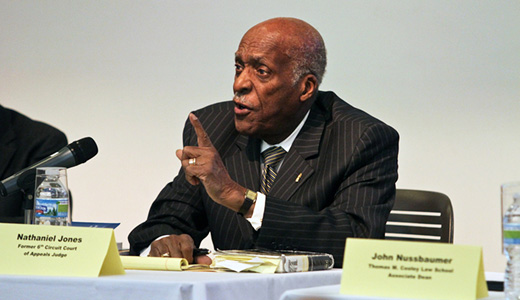
AUBURN HILLS, Mich. – A landmark 1974 Supreme Court case was a failed opportunity to strike a blow at school segregation in Michigan and around the nation, and we continue to suffer the consequences. The case and its significance was a key topic in a recent panel here, “From Redlining to White Flight, the History of Housing Segregation and the Importance of Regionalism,” sponsored by the Oakland University Thomas M. Cooley Law School and the Michigan Roundtable for Diversity and Inclusion.
As Cooley law student Amy Marino outlined in her opening remarks, the practice known as redlining meant minorities were forever stuck in neighborhoods destined to decline. They could neither move into more affluent neighborhoods nor receive the loans necessary to fix up their current residences. Neighborhoods that had once been racially mixed became exclusively Black.
But the horrible consequences of redlining went far beyond housing segregation. In Detroit and throughout the nation, it also laid the basis for segregated and unequal schools.
This point was driven home by retired U.S. Sixth Circuit Court of Appeals Judge Nathaniel Jones. As general counsel for the NAACP in 1974, Jones argued Milliken v. Bradley, a historic cross-district school bussing case, before the U.S. Supreme Court.
The case was a class action suit filed in 1970 by parents of students in the Detroit school system along with the Detroit NAACP branch against the Michigan State Board of Education and other state officials.
At the time, “desegregation was moving along in the South, but in the North, children were increasingly going to schools that were just of one race and providing inferior education for Black children,” Jones said.
He explained that a cross-district bussing plan was necessary because the Detroit Board of Education had promoted school segregation through the drawing of school boundaries, the construction of new schools in the center of segregated neighborhoods (away from district lines that might draw an integrated student population), and the assignment of teachers.
Such policies resulted in inferior education for minority students, Jones said. Schools in minority neighborhoods were so understaffed and overcrowded that the school day was shortened to three hours for some Black students.
Since the Detroit school board was under the power of the State Board of Education, the suit demanded that then-Governor William Milliken and the state assume responsibility.
A huge victory was won when a district court ruled the Detroit Board of Education had created and perpetuated school segregation in the city as a result of official policies. Not only did the court order the school board to submit Detroit-only desegregation plans but significantly, it also ordered state officials to submit desegregation plans encompassing 53 communities in the three-county metropolitan area.
However, hopes were soon dashed. At the Supreme Court, the lawsuit lost by a 5-4 vote.
Jones quoted Supreme Court Justice Byron White, one of the dissenters from the majority position, who called the ruling politically driven. “A change of one vote would have altered this nation,” Justice White said. “If the decision had gone the other way public education in this country would be totally different, the landscape of this nation would be different.”
Jones also quoted Justice Thurgood Marshall, who also dissented, saying, “The court may think it’s OK to divide our great metropolitan areas up into majority Black and majority white communities, but it’s a decision the country will come to regret.”
Another panelist in the program here, Clifford Schrupp, executive director of the Fair Housing Center of Metropolitan Detroit, cited Justice Marshall as well, as follows: “Desegregation is not and was never expected to be an easy task. Racial attitudes ingrained in our nation’s childhood and adolescence are not quickly thrown aside in the middle years. But just as the inconvenience of some cannot be allowed to stand in the way of the rights of others, so public opposition, no matter how strident, cannot be permitted to divert this Court from the enforcement of the constitutional principles at issue.”
In 1954, the Supreme Court ruled in Brown v. Board of Education that segregated schools are unequal schools, that diversity and quality go hand in hand.
Twenty years later, one vote kept that ruling from having an even broader impact.
In a talk in Detroit a few months ago, educator and author Diane Ravitch said school districts like Detroit, which tend to end up on the bottom of standardized test scores, are districts with “intense poverty, intense racial isolation.” She said, “Schools alone cannot right the wrongs of our society.”
The courts could have helped, but in this case unfortunately the nation’s highest court did not.
Photo: Retired Sixth Circuit U.S. Court of Appeals Judge Nathaniel Jones discusses the landmark Milliken v. Bradley case. Thomas M. Cooley Law School press image












Comments